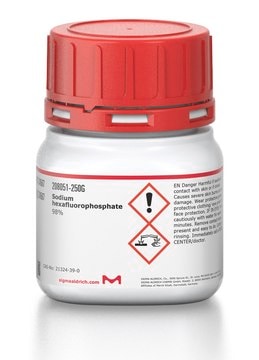GF19020620
Tin
rod, 500mm, diameter 3.0mm, 99.99+%
Synonim(y):
Tin, SN007918
Zaloguj sięWyświetlanie cen organizacyjnych i kontraktowych
About This Item
Wzór empiryczny (zapis Hilla):
Sn
Numer CAS:
Masa cząsteczkowa:
118.71
Numer MDL:
Kod UNSPSC:
12141745
Identyfikator substancji w PubChem:
NACRES:
NA.23
Polecane produkty
Próba
99.99%
Postać
rod
producent / nazwa handlowa
Goodfellow 190-206-20
rezystywność
11 μΩ-cm, 20°C
dł. × śr.
500 mm × 3.0 mm
tw
2270 °C (lit.)
mp
231.9 °C (lit.)
gęstość
7.310 g/mL at 25 °C (lit.)
ciąg SMILES
[Sn]
InChI
1S/Sn
Klucz InChI
ATJFFYVFTNAWJD-UHFFFAOYSA-N
Opis ogólny
For updated SDS information please visit www.goodfellow.com.
Informacje prawne
Product of Goodfellow
This page may contain text that has been machine translated.
Certyfikaty analizy (CoA)
Poszukaj Certyfikaty analizy (CoA), wpisując numer partii/serii produktów. Numery serii i partii można znaleźć na etykiecie produktu po słowach „seria” lub „partia”.
Masz już ten produkt?
Dokumenty związane z niedawno zakupionymi produktami zostały zamieszczone w Bibliotece dokumentów.
The newer essential trace elements, chromium, tin, nickel, vanadium and silicon.
W Mertz
The Proceedings of the Nutrition Society, 33(3), 307-313 (1974-12-01)
[Tin in the environment].
Iu P Popov et al.
Gigiena i sanitariia, (9)(9), 55-57 (1983-09-01)
K A Winship
Adverse drug reactions and acute poisoning reviews, 7(1), 19-38 (1988-01-01)
Inorganic tin salts are poorly absorbed and rapidly excreted in the faeces; as a result they have a low toxicity. Only about 5 per cent is absorbed from the gastrointestinal tract, widely distributed in the body, then excreted by the
Gabriel Santpere et al.
Genome biology and evolution, 7(6), 1490-1505 (2015-05-16)
We set out to investigate potential differences and similarities between the selective forces acting upon the coding and noncoding regions of five different sets of genes defined according to functional and evolutionary criteria: 1) two reference gene sets presenting accelerated
Are nickel, vanadium, silicon, fluorine, and tin essential for man? A review.
F H Nielsen et al.
The American journal of clinical nutrition, 27(5), 515-520 (1974-05-01)
Nasz zespół naukowców ma doświadczenie we wszystkich obszarach badań, w tym w naukach przyrodniczych, materiałoznawstwie, syntezie chemicznej, chromatografii, analityce i wielu innych dziedzinach.
Skontaktuj się z zespołem ds. pomocy technicznej


